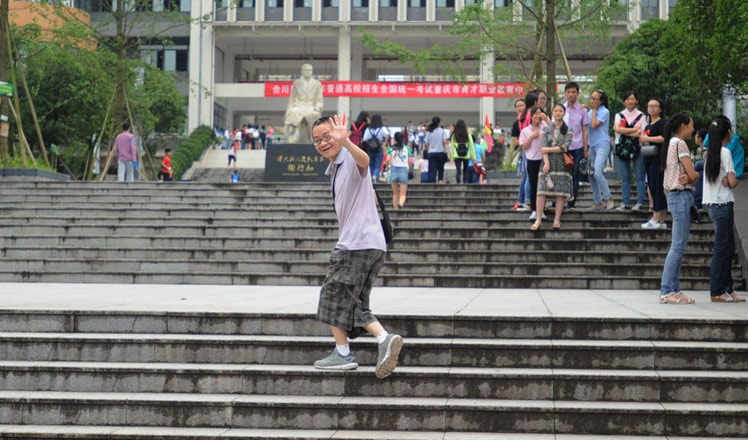Celebrating the bridges of Suzhou Creek
Updated: 2016-06-11 09:09
By Zhou Wenting(China Daily)
|
||||||||
 |
|
Shanghai's Waibaidu Bridge, a city icon, is a popular meeting place for couples. [Photo by Gao Erqiang/China Daily] |
The Shanghai government recently announced that a new Changping Road Bridge will be built in the area where the Shanghai Railway Station is at and where there are already seven bridges located roughly 480 meters apart from one another, citing the need to alleviate traffic congestion caused by a boom in the population of vehicles.
Construction of bridges over the Suzhou Creek, which snakes 17 km westward from downtown Shanghai and links the municipality with the city of Suzhou as well as other inland cities in Jiangsu province, began more than a century ago.
Most of the bridges along the eastern side of the creek were built before the 1940s and had European elements incorporated into them. Those on the west of the creek were introduced as the city started expanding.
The most famous of them all is arguably Waibaidu Bridge, or the Garden Bridge, situated at the confluence of the Huangpu River and the Suzhou Creek. Having been around for more than 140 years, this bridge is often seen in movies and promotional posters for Shanghai.
Numerous tour buses stop near the bridge every day as it is the starting point of the former concessions in the city. The wooden flooring on both sides of the bridge serves as an observation deck for tourists. From this point, people can enjoy the view of the rustic building clusters on the Bund, the narrow and old streets that criss-cross each other behind the waterfront stretch, and the breathtaking skyline of the Lujiazui financial district across the Huangpu River.
The bridge is itself a marvel to behold as well. Come nightfall, colorful neon lights illuminate the structure, turning it from a mere transportation tool to a romantic spot for lovers. In fact, engaged couples can often be spotted having their wedding photos taken at the bridge. The more adventurous ones even scamper onto the center of road when there is a short lull in traffic.
In 1856, the Wells Bridge was built over the Suzhou Creek, but it was barely utilized after locals complained about the toll charges. When a toll-free bridge was built 17 years later, people called it "waibaidu", which means "going across for free" in Mandarin and Shanghainese. This wooden bridge was then refurbished as a steel truss structure in 1907.
It is a tradition in Shanghai for a grandmother to carry her one-month-old grandchild across the bridge, as this symbolizes that the newborn has left behind all the twists and turns and will hence be able to get through life safely and smoothly.
"Waibaidu Bridge is a Shanghai icon. When my daughter was a baby she had a photo taken there with her grandmother too. It's been a family tradition for us to do so," said a Shanghai native Wang Xuefen.
- Suspected IS terrorists arrested in Germany
- Japanese boy abandoned by parents in Hokkaido forest found alive
- China to build Africa's biggest university library
- 'Kill list' found in UCLA campus shooter's residence: Police
- Swiss declare Alps tamed as Gotthard rail tunnel opens
- China urges Japan to properly settle Chinese forced laborers issue

 Euro powers land in France for UEFA EURO 2016
Euro powers land in France for UEFA EURO 2016
 The most unusualgaokao candidates in 2016
The most unusualgaokao candidates in 2016
 Elderly man carries on 1000-year old dragon boat craft
Elderly man carries on 1000-year old dragon boat craft
 Row your dragon boat, cute pandas in Yunnan!
Row your dragon boat, cute pandas in Yunnan!
 In pics: China's college entrance exam starts
In pics: China's college entrance exam starts
 Popular foods to break fast during holy month of Ramadan
Popular foods to break fast during holy month of Ramadan
 Top 10 biggest brands in Asia listed in media report
Top 10 biggest brands in Asia listed in media report
 Things you need to know about China's gaokao
Things you need to know about China's gaokao
Most Viewed
Editor's Picks

|

|

|

|

|

|
Today's Top News
Abe's blame game reveals his policies failing to get results
Ending wildlife trafficking must be policy priority in Asia
Effects of supply-side reform take time to be seen
Chinese State Councilor Yang Jiechi to meet Kerry
Chinese stocks surge on back of MSCI rumors
Liang avoids jail in shooting death
China's finance minister addresses ratings downgrade
Duke alumni visit Chinese Embassy
US Weekly

|

|









